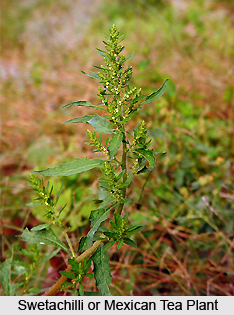Swetachilli holds the scientific name `Chenopodium ambrosioides L. This plant is named differently among the people of different languages. This plant is named as `Chandanbeto` in Bengali, `Khatua` in Hindi, `Guddavoma in Kannada, `Pookalachili` in Malayalam and `Kattasambadam` in Tamil.
 Swetachilli is foreign originated and it was naturalized almost throughout India to an altitude of 2300metre in the Himalayas as a weed in cultivated fields and other open, disturbed habitats. This plant is more common in Bangladesh, West Bengal, Kashmir and south India than in other parts of the Indian subcontinent.
Swetachilli is foreign originated and it was naturalized almost throughout India to an altitude of 2300metre in the Himalayas as a weed in cultivated fields and other open, disturbed habitats. This plant is more common in Bangladesh, West Bengal, Kashmir and south India than in other parts of the Indian subcontinent.
Swetachilli or Mexican tea plant is a profusely branched, erect herb or shrub with a strong camphorous smell and grows up to 1.5 metre tall. The stems are angular ribbed, short, pubescent, often purple tinged. Leaves are variable, linear lanceolate to oblong ovate, 4cm to 10cm long and 1cm to 3.5cm wide, lower leaves are coarsely serratedentate, upper ones are sub entire and glandular. Flowers are greenish; some flowers turn purple and are borne in small clusters together. They have simple or paniculate, axillary and terminal spikes. Fruits are more or less globular; seeds are small, reddish brown to black in colour, nearly smooth and have a bitter pungent taste. Flowers and fruits come out generally between September and July.
The herb is considered tonic, pectoral, emmenagogue and antispasmodic, and is also works as an essential medicine for the treatment of nervous conditions, particularly chorea. The herb is often dried and an infusion is created to use it in some medicines. The dried herb and the oil extracted from the seeds are used as anthelmintic against intestinal parasites including roundworms and hookworms. A tincture of the green leaves is prescribed as a cough suppressant. The pulverized leaves are used externally to promote healing of ulcers and sores. A decoction of the herb is given as an internal haemostatic, and the infusion as an enema to treat intestinal ulceration. The infusion of the plant is also diuretic and sudorific and used to treat colds and stomach-ache. Though the plant serves as a multifarious medicine, the consumption of this medicinal plant without consulting doctor may lead to mild hay fever. The seed oil is highly toxic and should not be taken internally.
The leaves and tender shoots of Swetachilli are eaten as a vegetable. Not only in India, this plant is also used outside India in treating diseases. In India and her neighbouring countries, infusions made from the leaves and seeds of the Swetachilli or Mexican tea plant have long been used as a household remedy against intestinal parasites.



















